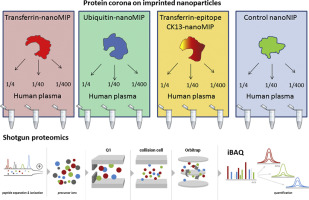Journal of Proteomics ( IF 3.3 ) Pub Date : 2020-03-19 , DOI: 10.1016/j.jprot.2020.103736 Annalaura Capriotti 1 , Susy Piovesana 1 , Riccardo Zenezini Chiozzi 1 , Carmela Maria Montone 1 , Alessandra Maria Bossi 2 , Aldo Laganà 1

|
“Plastic antibodies” are nano-sized biomimetics prepared by the molecular imprinting technology, which have the robustness of polymers, but specificity and selectivity alike natural receptors making them ideal for analytical uses. The current challenge is to translate plastic antibodies to in vivo applications for diagnosis, drug delivery, theranostic, therefore it is crucial to evaluate the effect of the biological sample complexity on the selectivity and the formation of protein corona (PCs), which ultimately dictate the fate of circulating nanoparticles.
A set (n = 4) of plastic antibodies (nanoMIPs) against different proteins was prepared. Quantitative (iBAC) shotgun proteomics permitted to define the PC composition of nanoMIPs in human plasma, the relative protein abundances, the correlation between PC and the plasma dilution.
NanoMIPs showed >200 proteins PC, while ~150 proteins were found on controls, suggesting the imprinting process influences the nanoparticle’s structure hence the protein uptake. NanoMIPs and controls shared the 44% of the PC, but PC iBAQ values on nanoMIPs were 10–100 times higher than controls, suggesting PC/nanoMIPs interactions were far stronger than PC/non imprinted particles. PCs were richer in small proteins and in immunoglobulins, indicating a defensive response, while the selectivity was negatively challenged in the crowded plasma sample.
Significance
The formation and the composition of the protein corona (PC) is key to decide the fate of nanoparticles when in vivo, therefore there is the strong need to study the composition of the PC.
To enable and to support the translation of the use of plastic antibodies (nanoMIPs), prepared by means of the molecular imprinting technique, to the clinical practice and to in vivo uses, the present work evaluates the effects of the complexity of the biological sample (plasma) on nanoMIPs composed of highly crosslinked polyacrylamide and acrylamide derivatives.
Proteomic study offers an in depth insight of the protein corona formed in plasma on nanoMIPs. A set of nanoMIPs synthesized and raised to recognize either small or large proteins was tested. The selection abilities of the nanoMIPs when placed in plasma at different dilutions was studied. Quantitative shotgun proteomics allowed to define the composition of the formed protein corona (PC) enabling to detail the protein compositions, the relative abundances, its correlation to the biological sample composition and the correlation between PC and nanoMIP’s imprinted template.
In plasma, all the nanoMIPs gained a PC composed of more than 200 proteins. Type of protein recruited for the corona, molecular weight and abundance in the PC were studied.
The PC on the nanoMIPs appeared to be driven by the protein composition of the plasma, while the template protein, towards which a nanoMIP was imprinted and that was proven to have high affinity for, did not influence the PC.
中文翻译:

蛋白电晕是否取代了分子印迹纳米颗粒的选择性?认识的生物学挑战
“塑料抗体”是通过分子印迹技术制备的纳米级仿生物,具有聚合物的坚固性,但特异性和选择性类似于天然受体,使其非常适合分析用途。当前的挑战是将塑料抗体转化为用于诊断,药物输送,治疗诊断的体内应用,因此,至关重要的是评估生物样品的复杂性对蛋白质电晕(PCs)选择性和形成的影响,最终决定了蛋白质的电晕。循环纳米粒子的命运。
制备了针对不同蛋白质的一组塑料抗体(nanoMIP)(n = 4)。定量(iBAC)gun弹枪蛋白质组学可以定义人血浆中nanoMIP的PC组成,相对蛋白丰度,PC与血浆稀释度之间的相关性。
NanoMIPs显示PC上有200种以上的蛋白质,而对照中发现了约150种蛋白质,这表明印迹过程会影响纳米颗粒的结构,从而影响蛋白质的摄取。NanoMIP和控件共享了PC的44%,但是nanoMIP上的PC iBAQ值比控件高10–100倍,这表明PC / nanoMIP的交互作用远强于PC /非印迹颗粒。PC富含小蛋白和免疫球蛋白,表明防御反应,而在拥挤的血浆样品中,选择性受到负面挑战。
意义
蛋白电晕(PC)的形成和组成是决定纳米粒子在体内命运的关键,因此强烈需要研究PC的组成。
为了使通过分子印迹技术制备的塑料抗体(nanoMIP)的使用能够转化为临床实践和体内使用,本研究评估了生物样品的复杂性(等离子)由高度交联的聚丙烯酰胺和丙烯酰胺衍生物组成。
蛋白质组学研究提供了对nanoMIPs血浆中形成的蛋白质电晕的深入了解。测试了一组合成并产生以识别大小蛋白质的nanoMIP。研究了当将纳米MIP置于不同稀释度的血浆中时的选择能力。定量shot弹枪蛋白质组学可以定义形成的蛋白质电晕(PC)的成分,从而可以详细说明蛋白质成分,相对丰度,其与生物样品成分的相关性以及PC与nanoMIP印迹模板之间的相关性。
在血浆中,所有的nanoMIP都获得了由200多种蛋白质组成的PC。研究了用于电晕的蛋白质类型,分子量和PC中的丰度。
nanoMIPs上的PC似乎受血浆蛋白质组成的驱动,而nanoMIP被印在其上并证明具有高亲和力的模板蛋白却不影响PC。

























 京公网安备 11010802027423号
京公网安备 11010802027423号